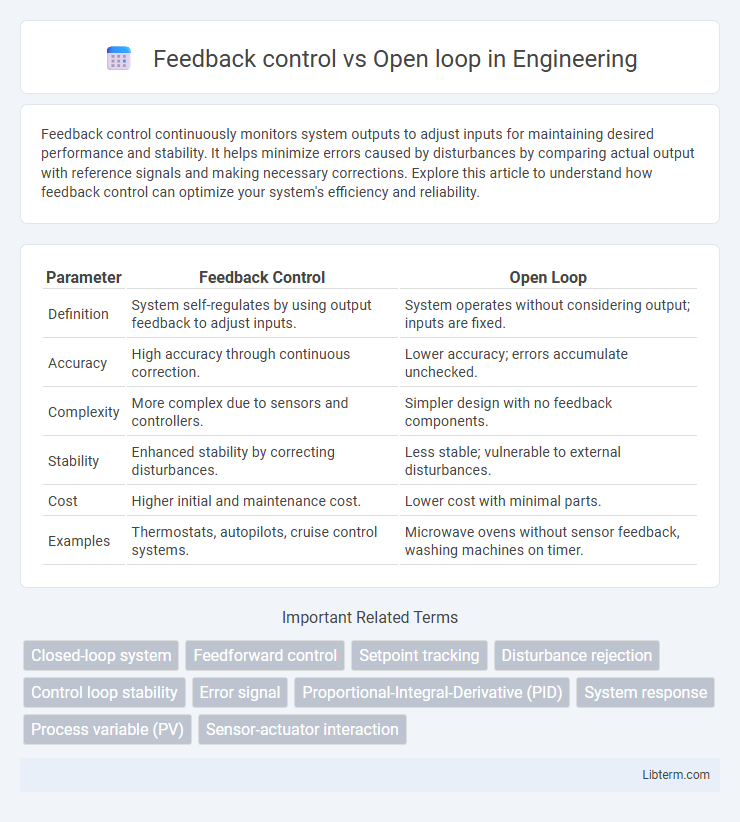Feedback control continuously monitors system outputs to adjust inputs for maintaining desired performance and stability. It helps minimize errors caused by disturbances by comparing actual output with reference signals and making necessary corrections. Explore this article to understand how feedback control can optimize your system's efficiency and reliability.
Table of Comparison
| Parameter | Feedback Control | Open Loop |
|---|---|---|
| Definition | System self-regulates by using output feedback to adjust inputs. | System operates without considering output; inputs are fixed. |
| Accuracy | High accuracy through continuous correction. | Lower accuracy; errors accumulate unchecked. |
| Complexity | More complex due to sensors and controllers. | Simpler design with no feedback components. |
| Stability | Enhanced stability by correcting disturbances. | Less stable; vulnerable to external disturbances. |
| Cost | Higher initial and maintenance cost. | Lower cost with minimal parts. |
| Examples | Thermostats, autopilots, cruise control systems. | Microwave ovens without sensor feedback, washing machines on timer. |
Introduction to Control Systems
Feedback control systems use sensors to monitor output and adjust inputs dynamically, ensuring system stability and accuracy under varying conditions. In contrast, open-loop control systems operate without feedback, relying solely on predetermined inputs, which can lead to errors if disturbances occur. Understanding the distinction between these control strategies is fundamental to designing efficient and reliable control systems in engineering applications.
Defining Open Loop Control
Open loop control systems operate without feedback, relying solely on predetermined instructions to perform tasks. These systems do not monitor output or adjust based on performance, making them simpler but less accurate in variable conditions. Common examples include washing machines and microwave ovens, where input signals directly control the actuator without real-time correction.
Defining Feedback Control
Feedback control continuously monitors system output by measuring actual performance and automatically adjusts inputs to minimize errors from desired values. This dynamic regulation enhances system stability, accuracy, and responsiveness compared to open loop control, which operates solely on preset commands without output verification. Key components of feedback control include sensors, controllers, and actuators working in a closed-loop to maintain optimal system behavior under varying conditions.
Key Differences Between Feedback and Open Loop Control
Feedback control systems continuously monitor output and adjust inputs to maintain desired performance, enhancing accuracy and stability. Open loop control operates without output monitoring, relying solely on predefined inputs, which can lead to errors if disturbances occur. The primary difference lies in feedback control's adaptive correction versus open loop's fixed execution.
Advantages of Feedback Control Systems
Feedback control systems offer superior accuracy and stability by continuously monitoring output and adjusting inputs to maintain desired performance. They adapt effectively to disturbances and system changes, reducing errors and enhancing reliability in dynamic environments. This adaptability ensures consistent operation in complex applications such as robotics, aerospace, and manufacturing processes.
Advantages of Open Loop Control Systems
Open loop control systems offer simplicity and cost-effectiveness due to their straightforward design without feedback mechanisms, making them suitable for processes with predictable and stable conditions. These systems provide faster response times as there is no delay caused by feedback signal processing or error correction. Furthermore, open loop controls require minimal maintenance and reduced computational resources, which enhances reliability in applications where precise accuracy is not critical.
Limitations of Feedback Control
Feedback control systems face limitations such as delays in response time that can cause instability or oscillations, particularly in rapidly changing environments. They rely heavily on accurate sensor measurements, and any noise or errors in the feedback signals can degrade system performance. Excessive feedback gain may lead to overcompensation, resulting in overshoot or sustained oscillations, limiting the effectiveness of the control system.
Limitations of Open Loop Control
Open loop control systems lack feedback mechanisms, making them unable to adjust or correct errors during operation, which limits accuracy and reliability in dynamic environments. These systems are susceptible to disturbances, parameter variations, and modeling inaccuracies since they operate purely on predetermined inputs without real-time data correction. The absence of feedback prevents compensation for external factors, resulting in reduced system performance and potential instability under varying conditions.
Real-World Applications: Feedback vs. Open Loop
Feedback control systems are widely used in real-world applications like automotive cruise control and industrial robotics for precise regulation based on system output. Open-loop control is common in simple processes such as washing machines and irrigation systems, where conditions are predictable and feedback is unnecessary. Feedback systems enhance accuracy and adaptability, while open-loop systems offer cost-effectiveness and simplicity in less dynamic environments.
Choosing the Right Control System
Selecting the appropriate control system depends on the application's complexity and accuracy requirements. Feedback control systems automatically adjust outputs based on real-time data, ensuring precision and stability in dynamic environments. Open loop systems operate without sensor input, making them cost-effective and suitable for simple, predictable processes where feedback is unnecessary.
Feedback control Infographic

 libterm.com
libterm.com